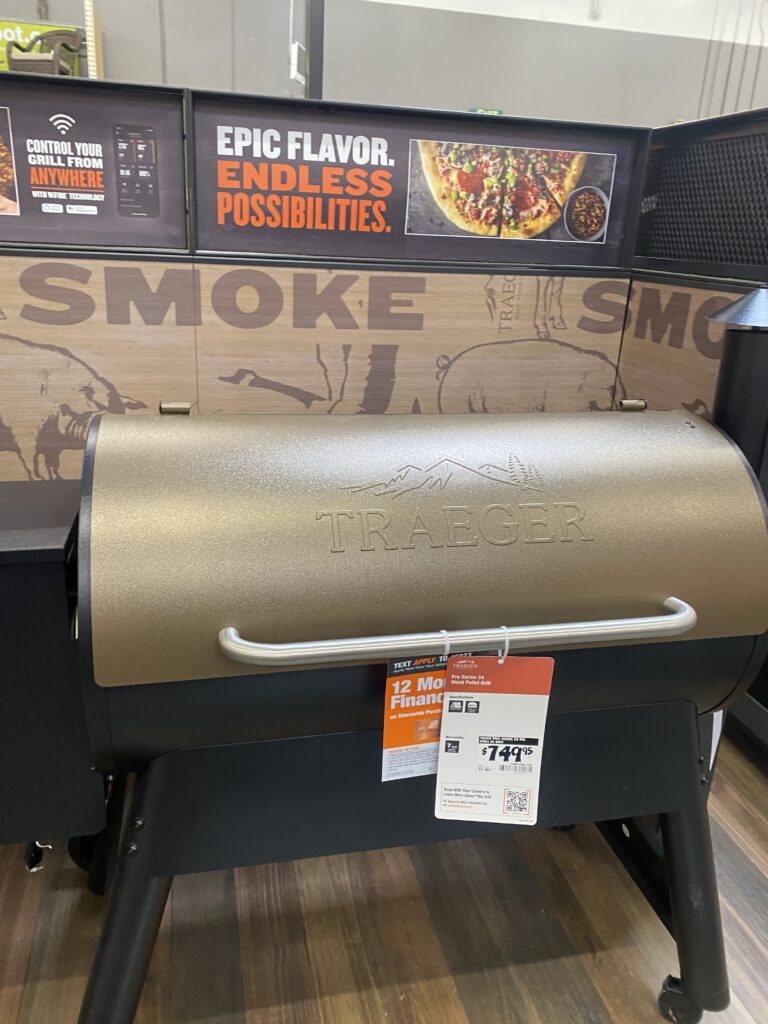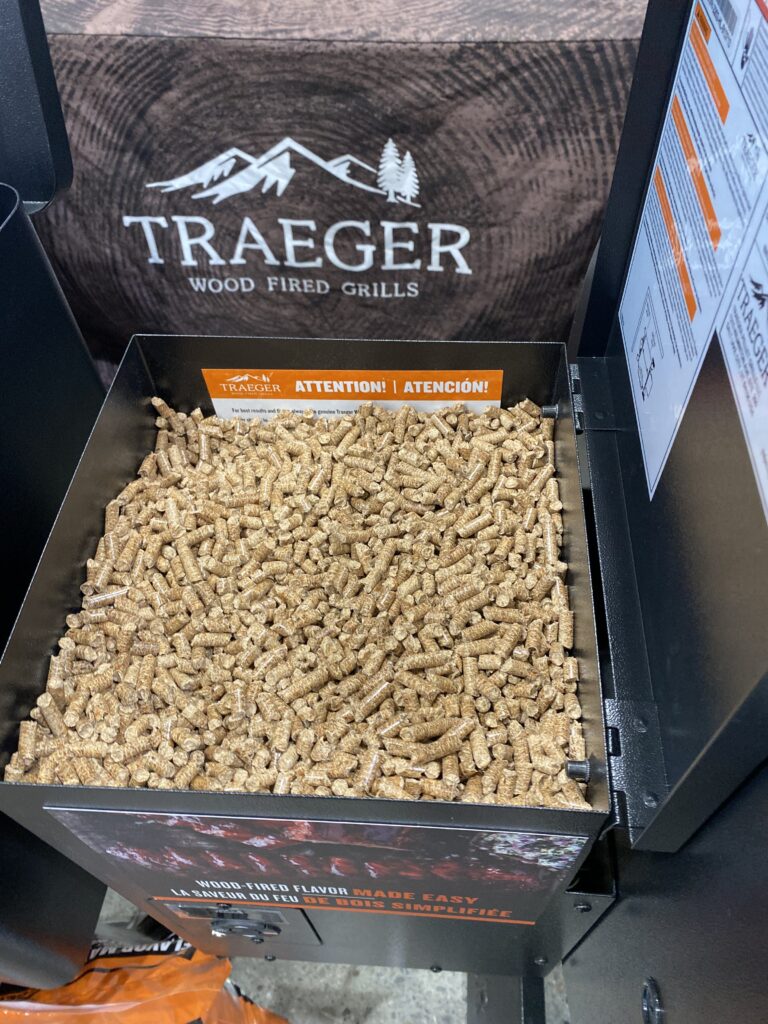We strive to provide you with authoritative, trustworthy, and expert advice. In doing so, the staff at bbqdropout.com performs extensive research, editing, and fact checking to every post on this webiste. If you feel that this article can improve, please feel free to reach us at staff@bbqdropout.com
Before continuing this article, I wanted to let you know that I have a YouTube channel where I showcase all sorts of video content related to BBQ. Subscribing would mean a lot to me, and I very much appreicate all the support!

Traeger Pellets no Flavor
Traeger’s wood pellets have been specially developed over decades of rigorous testing to create pellets that are responsibly sourced and burn consistently.
Though they are sometimes criticized by barbecue purists for creating smoke that doesn’t have a lot of flavor.
To answer this demand, Traeger offers six different varieties of wood pellets.
Some have accent woods in them as well as food-grade soybean oil, herbs or citrus.
This helps infuse a rich smoky flavor into a wide range of foods, including meats, cheese, and even vegetables.
If you want to further increase the smoke density in your Traeger grill, you can try setting the target temperature 25 to 50-degrees lower, which will create more of a smoldering fire.

Covering your Traeger with an insulating grill blanket will help hold in the heat as well as maximize the smoke density.
If this strategy still doesn’t provide enough rich flavorful smoke for your tastes, then you might want to consider some alternatives to Traeger pellets.
A few manufacturers have made a concerted effort to create flavorful pellets that cater directly to the demands of barbecue purists who love to grill with powerful, dense smoke.
Kingsford offers several types of wood pellets that are made from 100% of the named wood.
This lets you cook in your Traeger with potent 100% mesquite, pure hickory, or thick cherrywood smoke.

Lumberjack Grills and Cabela’s wood pellets include the bark of named accent woods which makes for a rich smoke.
Yet they still have an oak or alder base wood without any bark to optimize the wood pellet’s integrity.
Pit Boss offers 14 different varieties of wood pellets.
Many of the accent wood blends have a high percentage of the named wood to produce a smoke that is arguably more flavorful than Traeger’s pellets.

Another possible way to enhance the smoky flavor of your Traeger is to add a small amount of charcoal pellets.
A little goes a long way with these, so you only need a handful or two in 5 to 10 pounds of normal Traeger wood pellets.
Just don’t overdo it, as charcoal pellets leave behind a lot more ash and burn very hot.
Possible Alternative to Traeger Pellets
There are some competing manufacturers like Kingsford, Lumberjack Grills, and Pit Boss who offer some very flavorful pellets that create a rich, and flavorful smoke.
Though Traeger warns against using anything but their wood pellets as it could potentially cause mechanical issues that aren’t covered under Traeger’s standard warranty.
Kingsford is one of the best options for barbecue purists who want to pair specific cuts of meat with traditional smoking woods.
They offer several varieties of wood pellets that are made from 100% of the named wood.
They let you really enjoy the authentic smoke profile of a classic barbecue pit.
Lumberjack Grills and Cabela’s wood pellets have a higher percentage of bark from accent woods which makes for a rich smoke.

This is blended with oak or alder as a base wood to maintain the integrity and performance of the wood pellets.
Pit Boss and their parent company Louisiana Grills offer up to 14 different varieties of wood pellets.
Many of them have a high percentage of named accent wood in the blend to produce a strong, flavorful smoke.
They also tend to burn at a slightly lower temperature, which increases smoke density in most wood pellet grills.
Another way to increase the smoke density in your Traeger grill is to add a modest volume of charcoal pellets to the hopper.
Just a handful or two carefully mixed into 5 to 10 pounds of normal Traeger wood pellets will go a long way toward increasing the smoky flavor.
Just keep in mind that charcoal pellets leave behind a lot more ash and burn very hot, so you want to use a light hand.
Which Traeger Pellets Produce the Most Smoke?
Traeger offers up to 6 different variety blends with cherry, mesquite, and applewood producing the most smoke.
Honorable mention goes to their hickory blend, and signature series, which also do a good job of producing rich smoke.
How Do You Get Smoky Flavor on Traeger?
Dialing the target temperature down by 25 to 50 degrees will increase the smoke density on Traeger and most other wood pellet grills.
In general, the hotter you burn the pellets, the less smoke you get from them.
How you place specific meats can also increase their ability to absorb smoke.
Lightly scoring the fat cap on pork shoulder, picnic shoulders, and briskets, then placing them with the fatty side up will help these traditional barbecue cuts to absorb more smoke.
Then as the fat renders it carries that smoky flavor down into the deeper meat fibers.
Why Do Pellet Grills Have Less Smoke Flavor?
Wood pellets burn more efficiently than traditional chunks of smoking wood, which can reduce the amount of smoke they produce at higher temperatures.
They are also responsible for maintaining the consistent flame in the firepot, which means that they have a lower moisture content of around 5%.
This further reduces the amount of thick smoke that they give off.
Dialing down your Traeger by 25 to 50 degrees will slow the burn rate and create thicker smoke.
Covering your Traeger with a grill blanket will also help trap more smoke inside the primary chamber.
Do Traeger Grills Make Everything Taste Smoky?
Traeger grills do a great job of infusing a smoky flavor into a wide range of meats, cheese, and vegetables.
Though you tend to get the most smoke density at lower temperatures, which goes hand-in-hand with a lot of traditional barbecue cuts of meat.
How Does Traeger Flavor Their Pellets?
Traeger flavors some of their pellet blends with seasonings, all-natural citrus additives, and named wood fibers.
They also add a small amount of soybean oil to their wood pellets.
This is meant to help with lubrication in the auger shaft, and other moving components, but also adds a little more flavor to the smoke.
Final Thoughts
Traeger has spent decades developing a lineup of premium wood pellets that have a low moisture content, with flavors that are enhanced with accent woods, soybean oil, spices, and organic citrus additives.
However, they are criticized by some for not producing enough smoky flavor.
One easy way to increase the smoke density in a Traeger grill is to reduce the target temperature by 25 to 50-degrees.
This produces more of a smoldering fire with thicker smoke inside the primary chamber.
You could also try covering your Traeger grill with an insulating grill blanket to help hold in the heat, while also boosting the smoke density.

If you still aren’t getting enough flavor out of your Traeger, you may want to try an alternative brand of wood pellets.
Several manufacturers offer flavorful pellets that cater directly to barbecue purists who demand strong, flavorful smoke.
Kingsford uses 100% of the named wood in several of its wood pellet varieties.
This lets you smoke meat in your Traeger with flavorful 100% mesquite, pure hickory, or thick cherrywood.
Lumberjack Grills, who also makes Cabela’s wood pellets uses a higher percentage of the bark of named accent woods in many of their pellet varieties.
This helps produce a rich flavorful smoke in a Traeger, especially when smoking at low barbecue temperatures.
Pit Boss has 14 different varieties of wood pellets, with many having a high percentage of accent wood to produce a smoke that is arguably more flavorful than Traeger’s pellets.
They do especially well at producing a flavorful smoke at low temperatures between 225 to 250-degrees.
Robert is a certified Pitmaster, with over a decade of experience in smoking the best meats you’ll ever feast upon. He also has a Bachelor of Business Administration from the University of Texas at San Antonio. When he’s not researching technical topics, he’s most likely barbecuing in his backyard.
